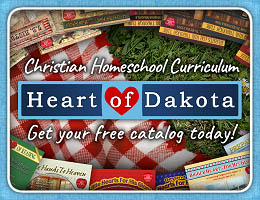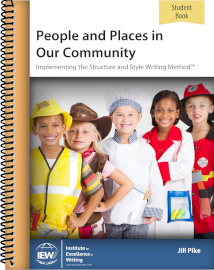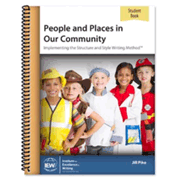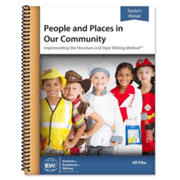People and Places in Our Community: Implementing the Structure and Style Writing Method makes it easy for parents of first- and second-graders (and some third-graders) to teach the Structure and Style method of writing.
To teach this course, a parent or teacher must be familiar with IEW’s Teaching Writing: Structure and Style (TWSS), since this course implements the methodology step by step. However, parents can also learn the methodology as they go, staying a step ahead of their children. The lessons have such thorough instructions for the teacher that it might be tempting to forego the teacher training course, but parents who understand the methodology as it is applied at all levels will better understand the layout and purpose of the lessons in People and Places and how they can continue to expand upon and apply the methodology as their children grow.
The course has a student book and a teacher’s manual. Purchasers of the student book can download the teacher’s manual for free; however, they can also purchase a spiral-bound printed book if desired. Viewing the digital teacher’s manual should work fine. Each student needs their own consumable book.
The entire Structure and Style method is taught through nine units as listed below. In People and Places, students learn the skills taught in Units 1 through 5 and Unit 7.
- Note Making and Outlines
- Writing from Notes
- Retelling Narrative Stories
- Summarizing a Reference
- Writing from Pictures
- Summarizing Multiple References
- Inventive Writing
- Formal Essay Models
- Formal Critique
The other three units are taught later in other courses.
As with other courses based on TWSS, students begin by identifying and recording key words from sentences in a source text, generally one paragraph long in this course. Students then reconstitute the paragraph, incorporating the key words and filling in with their own words. This course has students begin by saying each of their sentences aloud. They gradually start to write them down, with assistance as needed. Checklists help them pay attention to details and requirements for each composition. Even when students write their own compositions, they will present them aloud to practice public speaking skills. This same process is applied to pictures in a later unit, with students relating what is happening in each picture.
For the primary grades, parents are encouraged to help children as much as they need, by reading aloud the lessons and the source texts, by helping students identify key words to create outlines, by modeling for them how to create their own sentences based on key words, by doing the writing for children as needed, etc. Applying the methodology over several years means that students eventually complete all nine units. Then they repeat the nine-unit cycle several times, gradually adding more “dress-ups,” more sophisticated sentence structures (e.g., -ly adverbs and because clauses), lengthier compositions, essays, and critiques.
Appendices in the student book provide critical elements of the course. The first appendix has reference charts with -ly adverbs, lists of interesting verbs and adjectives to use in place of bland ones, and a list of prepositions. The second appendix has pages for a few lessons that are to be cut and pasted for use as manipulatives, plus a two-page “board” game and cards. A third appendix has vocabulary cards and instructions for two games.
While developing composition skills is the primary focus, vocabulary work is an important part of each course as students learn to “dress up” their writing with interesting words. The vocabulary cards have words and illustrations on one side and definitions and a sample sentence on the reverse. (The cardstock pages with the vocabulary words are to be cut apart as new words are introduced.) Vocabulary words relate to topics in the source texts, so students are encouraged to incorporate vocabulary words into their rewrites from their key-word outlines.
Summary
Many homeschoolers probably think that the Structure and Style methodology must wait until at least third or fourth grade, but that’s not the case. People and Places in Our Community applies TWSS methodology at a level that should be manageable for children in the primary grades, as well as for parents new to TWSS.











